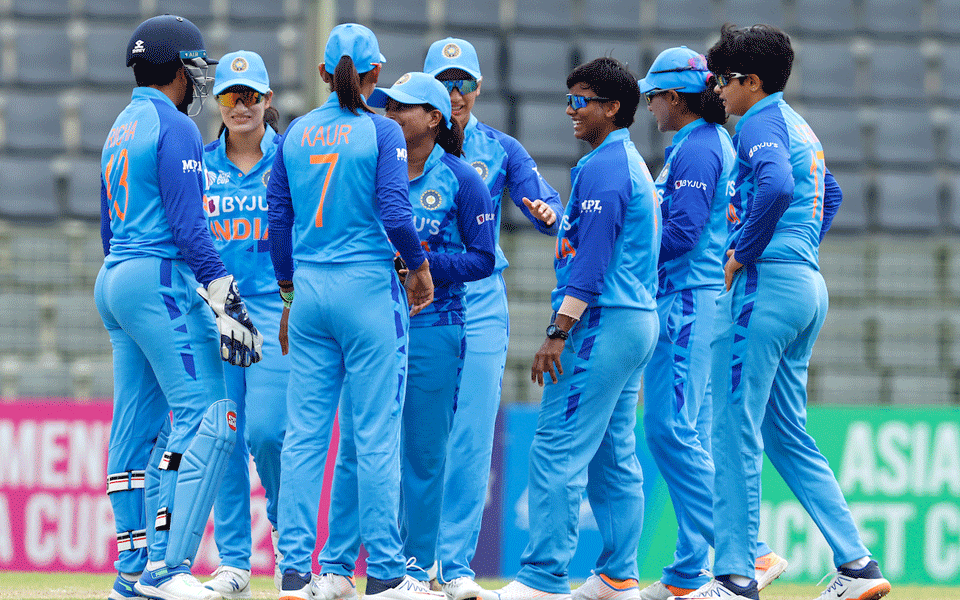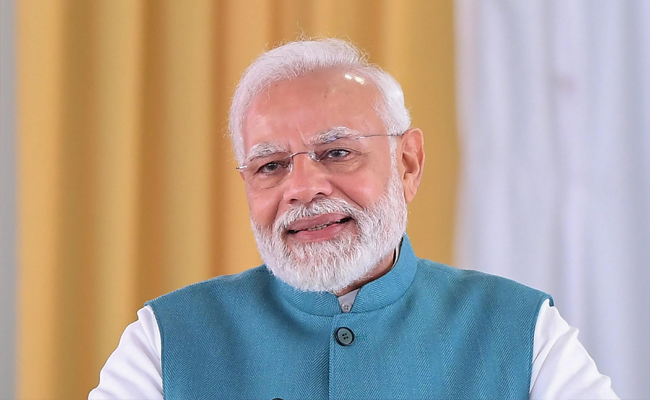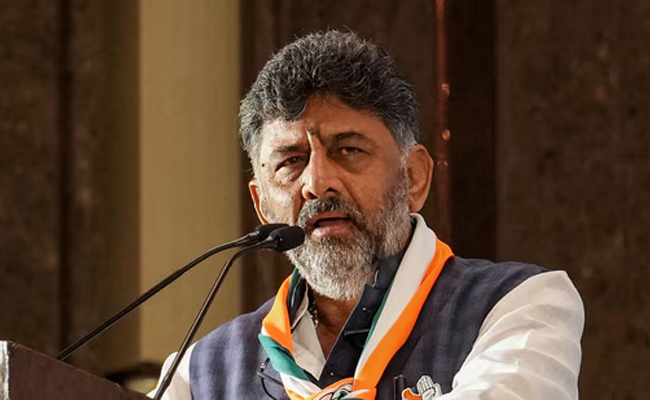Sylhet (PTI): A dominant India crushed minnows Thailand by 74 runs to storm into the final and remain on course for a record-extending seventh women's Asia Cup title here on Thursday.
The win over Thailand took India to their eighth straight Asia Cup final - four each in ODI and T20 formats. Before 2012, the tournament was a 50-over-a-side affair.
The semifinal contest against Thailand was always expected to be a cakewalk for India and it turned out to be so. India posted 148 for six after being sent in to bat and then restricted Thailand to 74 for 9 in the lop-sided contest.
Chasing the target, Thailand were never in the hunt as they lost wickets at regular intervals.
The Thai women, however, fared much better than their previous outing against India in the league stage, where they were crushed by nine wickets.
In that match, the Indians bundled out Thailand for just 37 runs in 15.1 overs and then chased down the target with consummate ease.
On Thursday, the Thai women gave a better account of themselves with the bat despite being reduced to 21 for 4 in the eighth over.
Deepti Sharma (3/7) did most of the damage with her off-spin, picking up the first three Thai wickets -- Nannapat Koncharoenkai, Natthakan Chantham and Sornnarin Tippoch -- in consecutive overs.
Medium pacer Renuka Singh (1/6) then cleaned Chanida Sutthiruang as Thailand's chase fell apart.
Captain Naruemol Chaiwai (21) and Nattaya Boochatham (21) showed some resistance with the bat with a 42-run stand for the fifth wicket but the asking rate was too tall. In fact, they were the only two Thai batters to register double digit scores.
Once the duo departed, the Indian bowlers just ran through Thailand lower-order batting line-up.
Rajeshwari Gayakwad (2/10), Shafali Verma (1/10) and Sneh Rana (1/16) were the other wicket takers for India.
Earlier, invited to bat, Shafali Verma was at her destructive best, top-scoring for India with a 28-ball 42 with the help of five boundaries and one hit over the fence.
Together with vice-captain Smriti Mandhana, Verma shared 38 runs in 4.3 overs before the former hit a low full toss from Phannita Maya straight to Onnicha Kamchomphu at mid on.
Verma continued her attacking batting but was the next batter to depart, miscuing off-spinner Sornnarin Tippoch's flighted delivery to Thailand skipper Naruemol Chaiwai at short midwicket.
Most of the dismissals were gifts to Thai bowlers as the Indian batters were guilty of giving away their wickets after getting starts.
Jemimah Rodrigues (27) was the next to loft one straight to Rosenan Kanoh at long-on off Thipatcha Putthawong.
Tippoch then had two wickets in successive overs to reduce India to 132 for 5 in the 18th over.
First, she caught wicketkeeper Richa Ghosh plumb in front of the wicket and an over later, got the big wicket of skipper Harmanpreet Kaur as the batter tried to clear the cover boundary.
Harmanpreet, who returned to lead the side after missing out two matches due to a niggle, looked in good nick and laced her 30-ball 36 with four hits to the fence.
Towards the end, Pooja Vastrakar hit a quick 13-ball 17 with the help of a six to take India close to the 150-run mark.
Sornnarin Tippoch was the best bowler for Thailand with figures of 3/24.
India had made three changes from their last match playing eleven with Harmanpreet, Renuka Thakur and Radha Yadav coming in for S Meghana, Meghna Singh and Kiran Navgire.
Let the Truth be known. If you read VB and like VB, please be a VB Supporter and Help us deliver the Truth to one and all.
Dharamsala (PTI): The countdown to save his place in the playing XI begins for a beleaguered Shubman Gill, who is likely to get three matches against South Africa to prove his worth before the Indian team management switches to a ‘Plan B’ ahead of the T20 World Cup, starting in six weeks.
As India gear up to play the third T20I against the Proteas on Sunday in sub-10-degree temperatures in the lap of the ice-clad Dhauladhar range, things are suddenly heating up in the Indian dressing room, with the prolonged poor form of skipper Suryakumar Yadav coming under the scanner.
ALSO READ: South Africa level series after de Kock special; Gill, SKY misfire again
Worse, his deputy Shubman Gill, who was pushed into the XI at the expense of a settled Sanju Samson, is not inspiring much confidence.
The South African pace attack featuring Anrich Nortje, Marco Jansen, Lungi Ngidi, Ottniel Baartman and Lutho Sipamla — has shown how to bowl on Indian tracks, and the HPCA Stadium strip, offering extra bounce and some movement off the surface, will certainly keep them interested.
ALSO READ: Messi mania grips Kolkata as thousands welcome Argentine icon at 2.26 am
Among all T20 sides, South Africa, in terms of personnel, appears to have the requisite balance to win the trophy in the Indian subcontinent this time. Quinton de Kock’s return, along with the likes of Aiden Markram, Dewald Brevis, Donovan Ferreira, David Miller and all-rounder Jansen, gives their batting an intimidating look.
With only eight games, starting from the third T20I, left before the start of the T20 World Cup title defence, India's under-fire head coach Gautam Gambhir won't be able to afford, two out-of-form top-order batters in the starting line-up.
Being the skipper of the side, Surya will certainly have immunity going into the T20 World Cup despite being completely out of form for the past one year but same can't be said about Gill, who wasn't the original choice as an opener.
Gill's entry into the T20 set-up was a classic case of trying to fix something that ain't broken and things haven't looked good so far.
In this backdrop, Gill would need to bat out of his skin to prove that Ajit Agarkar-led committee wasn't wrong in throwing Samson under the bus for one bad series against England.
The stylish Indian Test and ODI skipper will have to find his T20 game and at least score in two of the three matches if he doesn't want Samson to get his rightful place back or for that matter, find Yashasvi Jaiswal, with a fabulous T20I strike-rate of 165, enter the fray during New Zealand series.
Lack of clarity
==========
While head coach Gambhir is too proud a person to admit but sending Axar Patel as a one drop batter during the second T20I was a "tactical brain fade" from the team's think-tank.
The kind misstep that was taken with Axar's promotion is unlikely to be repeated in the third game where skipper is expected to go back to No.3 where he has got a lot of success in his first few years at the international level.
Similarly, Shivam Dube being sent at number eight due to the shuffling of batting order was another poor call which would need course correction in the next game.
Is there a place for Kuldeep Yadav?
=========================
Kuldeep Yadav is one bowler who has consistently troubled the Proteas batter but in an Indian team where batting till No. 8 is non-negotiable, the left-arm wrist spinner often finds himself getting the rough end of the stick.
At Dharamsala too, he might have to sit out as Kuldeep and Varun Chakravarthy, two non-batters can't be clubbed in the same T20 playing eleven as that would lead to compromise in batting depth.
While Arshdeep hasn't had a good series so far, it will be interesting to find if team management can find a place for Kuldeep in the playing eleven with Hardik Pandya sharing the new ball with Jasprit Bumrah.
The five-match series is currently tied 1-1.
Teams:
India: Suryakumar Yadav (captain), Shubman Gill, Abhishek Sharma, NT Tilak Verma, Axar Patel, Hardik Pandya, Shivam Dube, Jitesh Sharma (wk), Varun Chakravarthy, Arshdeep Singh, Jasprit Bumrah, Sanju Samson (wk), Harshit Rana, Kuldeep Yadav, Washington Sundar.
South Africa: Aiden Markram (captain), Quinton de Kock, Reeza Hendricks, Dewald Brevis, David Miller, Tristan Stubbs, Donovan Ferreira, Marco Jansen, Lutho Sipamla, Ottniel Baartman, Anrich Nortje, Lungi Ngidi, Corbin Bosch, Keshav Maharaj, George Linde.
Match Starts at 7 pm.





